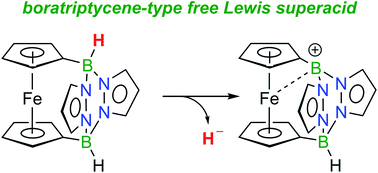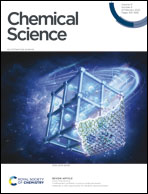A free boratriptycene-type Lewis superacid†
Abstract
Bicyclic pyrazabole-bridged ferrocenes with BH groups at their bridgehead positions were prepared from [Li(thf)]2[1,1′-fc(BH3)2] and pyrazole or 3,5-dimethylpyrazole in the presence of Me3SiCl (1 or 1Me, respectively; 1,1′-fc = 1,1′-ferrocenylene); Me3SiH and H2 are released as byproducts. Treatment of 1 or 1Me with 1 eq. of the hydride scavenger [Ph3C][B(C6F5)4] afforded the borenium salts [2][B(C6F5)4] (72%) and [2Me][B(C6F5)4] (77%). According to X-ray crystallography, [2Me]+ contains one trigonal-planar borenium cation, the cyclopentadienyl (Cp) rings of the 1,1′-fc fragment remain parallel to each other, but the Cp–B bond vector is bent out of the Cp plane by an unprecedentedly large dip angle α* of 40.6°. The Fe⋯B(sp2) distance is very short (2.365(4) Å) and the 11B NMR signal of the cationic B(sp2) center is remarkably upfield shifted (23.4 ppm), suggesting a direct Fe(3d) → B(2p) donor–acceptor interaction. Although this interpretation is confirmed by quantum-chemical calculations, the coupling between the associated orbitals corresponds to an energy of only 12 kJ mol−1. Accordingly, both the experimental (e.g., Gutmann–Beckett acceptor number AN = 111) and theoretical assessment (e.g., Et3PO and F−-ion affinities) of the Lewis acidity proves that [2]+ is among the strongest boron-based Lewis acids available to date.

- This article is part of the themed collection: 2021 Chemical Science HOT Article Collection


 Please wait while we load your content...
Please wait while we load your content...